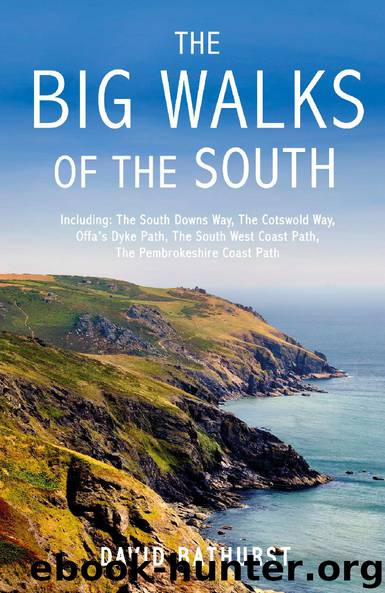THE BIG WALKS OF THE SOUTH by DAVID BATHURST

Author:DAVID BATHURST
Language: eng
Format: epub
Publisher: Summersdale Publishers Ltd in 2007
Published: 2011-09-19T00:00:00+00:00
The South West Coast Path
HIGHLIGHTS OF THIS WALK
(There are hundreds on the Coast Path but to my mind these stand out as being of special interest):
Valley of Rocks
Hartland Point
High Cliff
Tintagel
Cape Cornwall
Lizard
Polperro
Bolt Head
Lyme Regis
Durdle Door
Designation: National trail.
Length: 628.5 miles.
Start: Minehead, Somerset.
Finish: South Haven Point, near Poole, Dorset.
Nature: A walk round the often rugged and spectacular coastline of the south-western counties of England, covering the entire coastlines of Devon and Cornwall, and sections of the coastline of Somerset and Dorset. Difficulty rating: Strenuous, severe in places.
Average time of completion: 6–7 weeks in aggregate.
NB: All mileages assume the most direct routes are taken. Separate mileages are given for alternatives to seasonal ferries. No alternative routes, or mileages for these alternatives, are given in respect of ferries used by the Coast Path that run all year.
The statistics speak for themselves. This enormous coastal trek is a truly awesome logistical challenge for any walker, however fit or experienced. Yet foot-travellers whose ambition it is to complete all the big walks in Great Britain will at some stage have to rise to it.
The glorious coastal scenery of Somerset, Devon, Cornwall and Dorset, with high cliffs, quaint villages, cosy harbours, sandy coves and dramatic peninsulas, acquired popularity with holidaymakers and walkers long before any suggestion was raised of a continuous coast path. The idea of joining up the numerous existing rights of way along these coasts to create an unbroken route came from a wartime committee of the Ramblers’ Association. It was given official blessing in the National Parks and Access to the Countryside Act of 1949, and thereafter each of the four county councils involved set about designating and waymarking the route. Progress was slow, and although most of the necessary work had been done by the end of the 1970s, there were still some sections that required negotiation at that time. Even at the time of writing, although a continuous route is available to walkers, not all the work has been done to provide a true coastal route throughout, and in one or two places it is necessary to detour to existing rights of way inland to maintain the continuity. The fact is, however, that no two walkers will follow exactly the same route for a number of reasons. There are some ‘cul-de-sacs’ to headlands that involve detours, and which may be omitted if time is pressing; for example, the Lulworth–Kimmeridge section of the Dorset coast is only open at certain times and an official inland alternative is prescribed. Some river and estuary crossings may be undertaken by ferry, and whilst many of the ferry trips are actually incorporated into the official route, even some of these do not operate out of season, and lengthy foot detours may therefore be necessary (suggested alternatives to seasonal ferries are shown in italics, but you may prefer to use taxis if short of time – I assure you it is not cheating!).
Unless you are incredibly fit and in the fortunate position of having sufficient time and resources available,
Download
This site does not store any files on its server. We only index and link to content provided by other sites. Please contact the content providers to delete copyright contents if any and email us, we'll remove relevant links or contents immediately.
Bodyweight Strength Training by Jay Cardiello(7202)
Tools of Titans by Timothy Ferriss(6983)
Born to Run: by Christopher McDougall(6290)
Inner Engineering: A Yogi's Guide to Joy by Sadhguru(5923)
Asking the Right Questions: A Guide to Critical Thinking by M. Neil Browne & Stuart M. Keeley(4610)
The Fat Loss Plan by Joe Wicks(4253)
Bodyweight Strength Training Anatomy by Bret Contreras(4073)
Yoga Anatomy by Kaminoff Leslie(3719)
Science and Development of Muscle Hypertrophy by Brad Schoenfeld(3589)
Dynamic Alignment Through Imagery by Eric Franklin(3506)
The Four-Pack Revolution by Chael Sonnen & Ryan Parsons(3492)
ACSM's Complete Guide to Fitness & Health by ACSM(3476)
Yoga Anatomy by Leslie Kaminoff & Amy Matthews(3414)
Bodyweight Strength Training: 12 Weeks to Build Muscle and Burn Fat by Jay Cardiello(3370)
The Ultimate Bodybuilding Cookbook by Kendall Lou Schmidt(3343)
Exercise Technique Manual for Resistance Training by National Strength & Conditioning Association(3307)
Nutrition for Sport, Exercise, and Health by Spano Marie & Kruskall Laura & Thomas D. Travis(3248)
Nutrition for Sport, Exercise, and Health by Marie Spano & Laura Kruskall & D. Travis Thomas(3246)
Yoga Therapy by Mark Stephens(3238)
